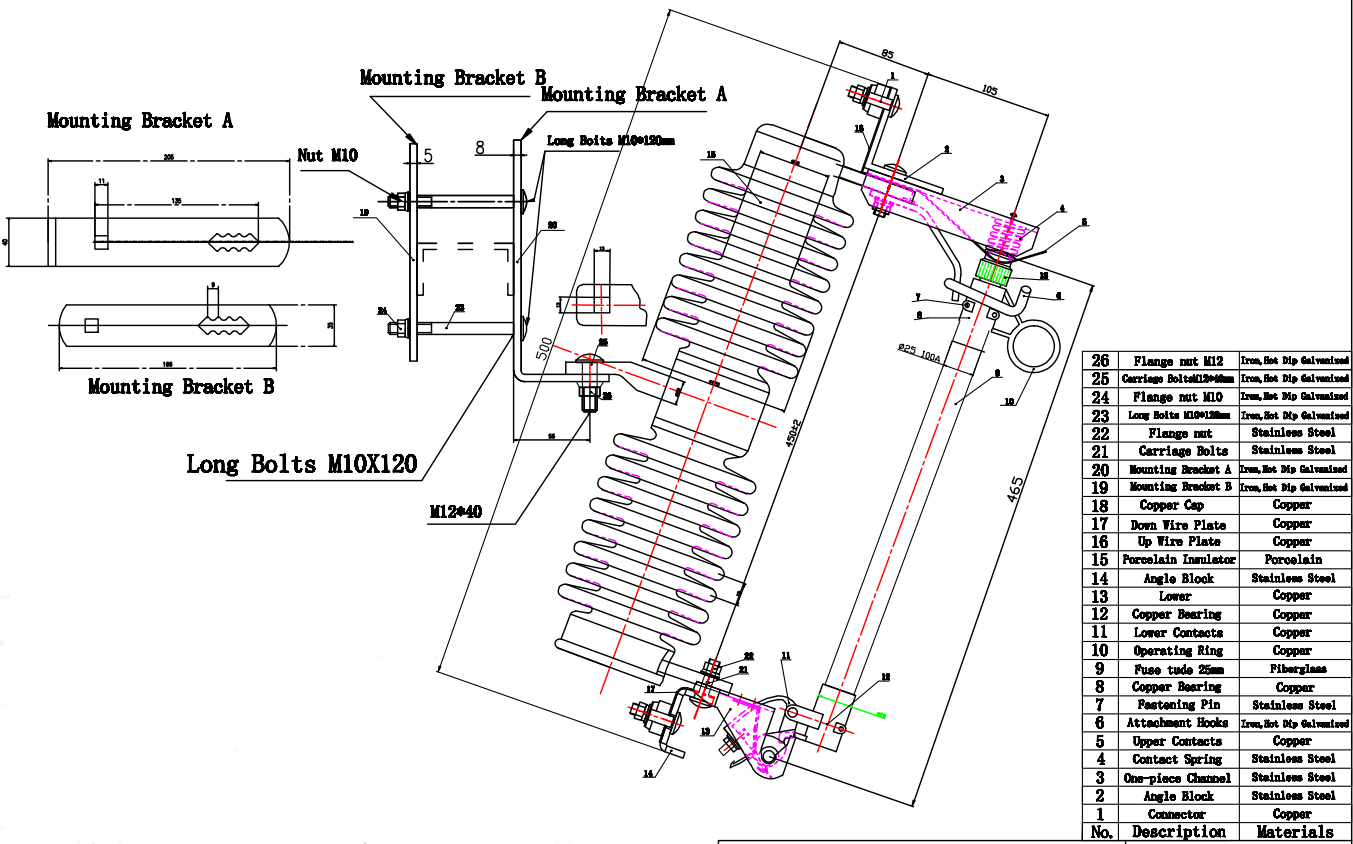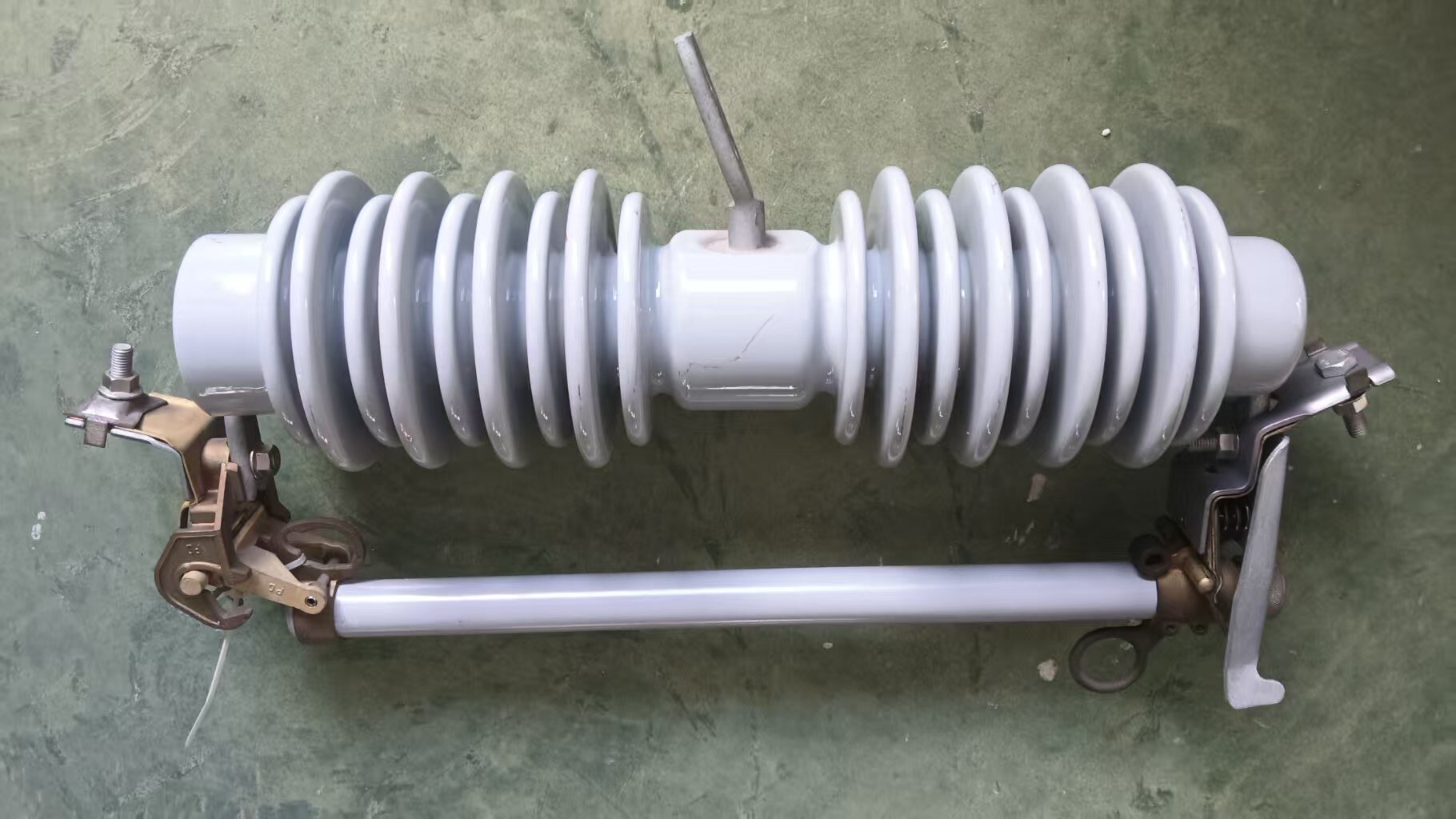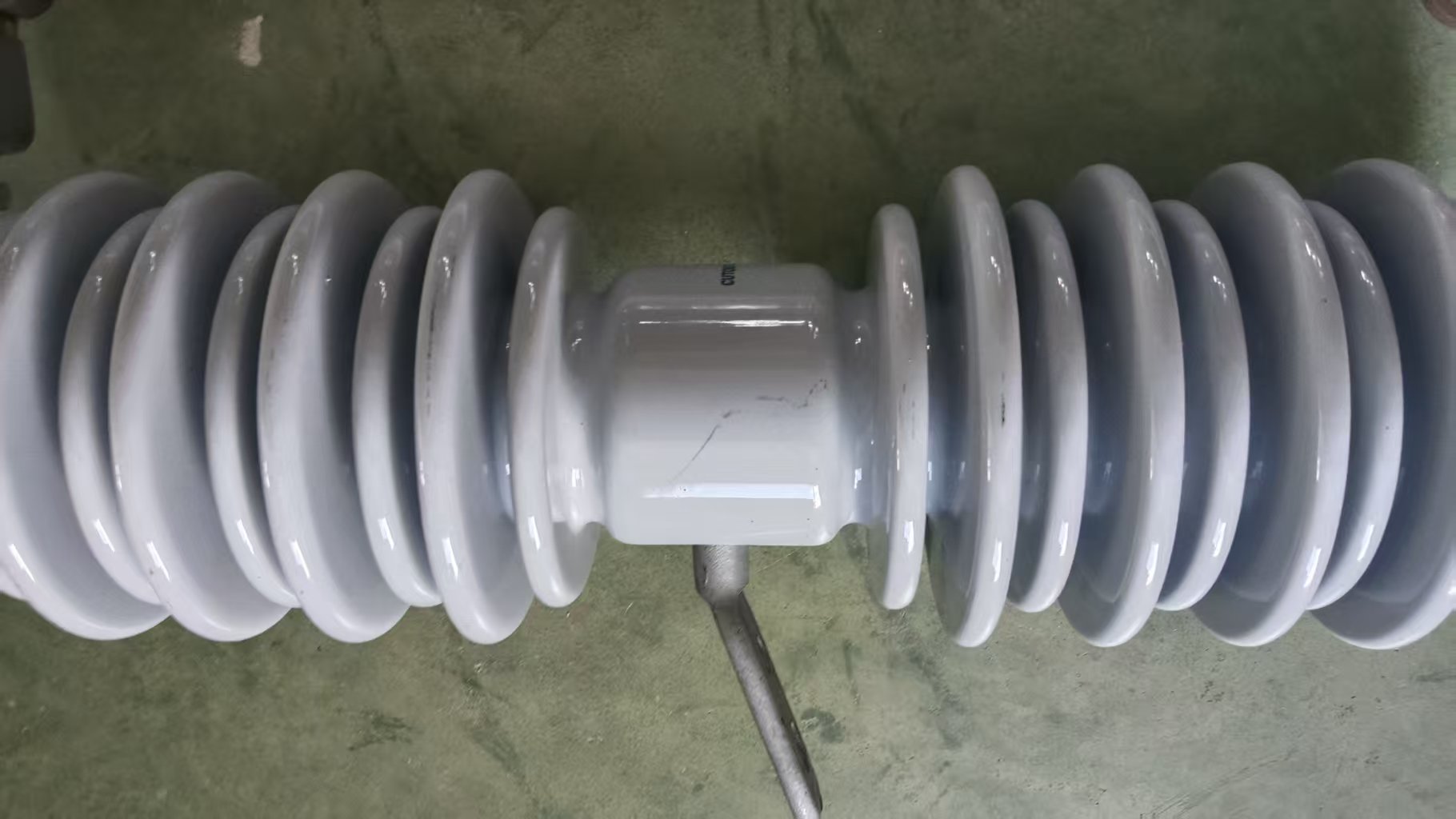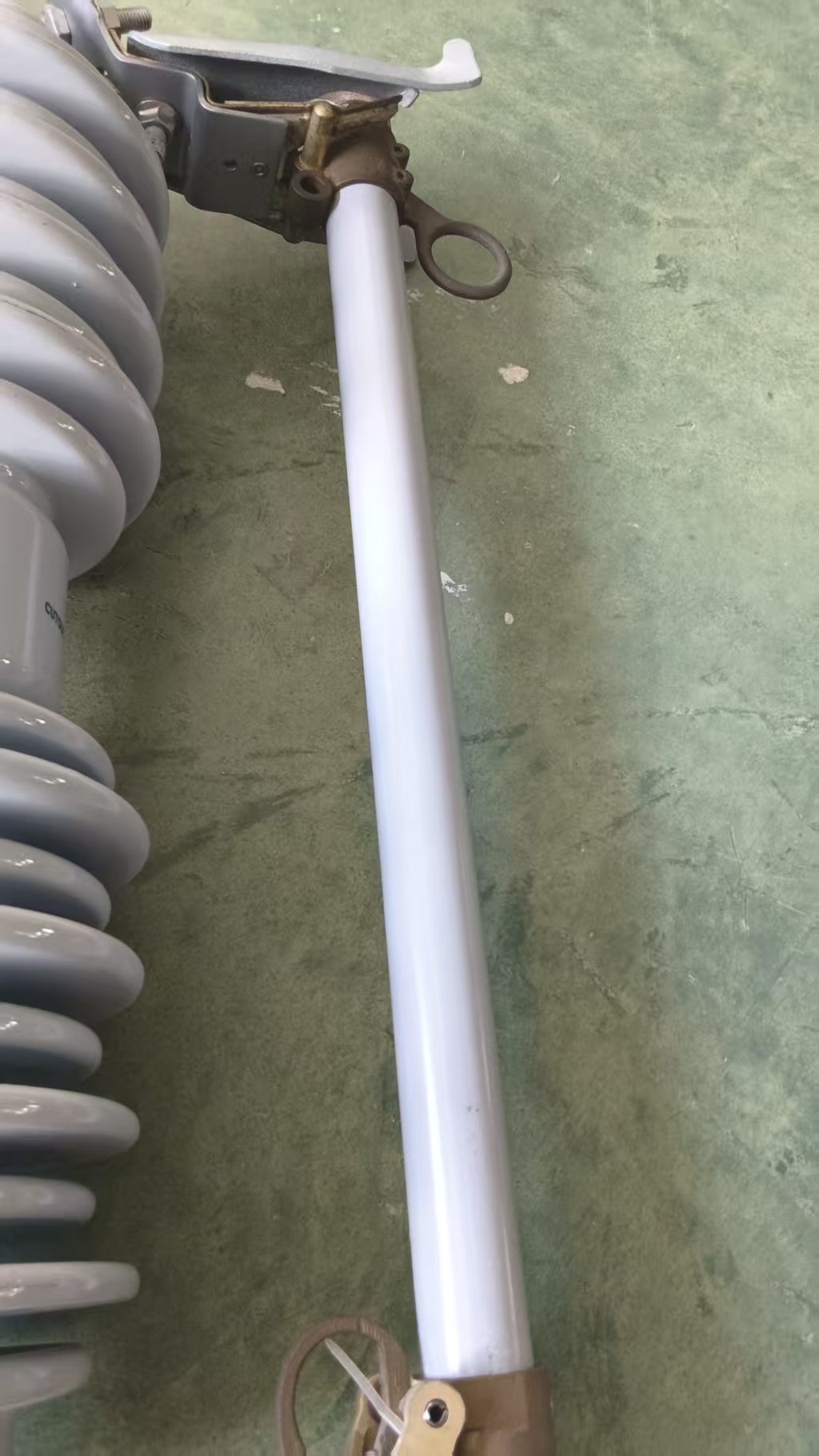| Availability: | |
|---|---|
| Quantity: | |
Product Size:


Specifications:
Product Name: Porcelain Fuse Cutout( is also named Ceramic Drop Out Fuse, Ceramic Fuse Outout)
Product Type: RW10-33-100A
Body - porcelain
Rated voltage: 33kv
Rated current: 100A
Breaking current: 10kA
Impulse voltage (BIL): 170kV
Power frequency withstand voltage: 70kV
Leakage distance: 660mm
Weight: 15.5kgs
Dimensions: 640x450x170mm
1. Product Description
This 33kV, 100A Drop-Out Fuse is a high-voltage overcurrent protection device designed for medium-voltage power distribution systems. Featuring robust porcelain insulators and an extended 660mm creepage distance, it ensures reliable fault isolation and enhanced performance in harsh environments, though the absence of an arc quenching chamber limits its interruption capabilities for high-energy faults.
2. Construction
- Base Assembly:
Heavy-duty galvanized steel bracket for pole/crossarm mounting, engineered for mechanical stability at 33kV.

- Porcelain Insulators:
High-alumina ceramic providing exceptional dielectric strength (>170kV BIL)
Superior resistance to thermal shock, UV degradation, and environmental corrosion
660mm creepage distance** (exceeds IEC 60815 Class IV requirements for severe pollution)

- Fuse Carrier:
Pivoting mechanism with gravity-driven "drop-out" action for visual fault indication
Houses replaceable fuse element (no integrated arc quenching)

- Fuse Link:
Precision-calibrated silver or tin-alloy element
Rated for 100A continuous current with time-current characteristics per IEC 60282-1
3. Key Technical Features
Extended Creepage Design (660mm):
- Pollution Resistance:Prevents surface tracking in heavy contamination (salt fog, industrial dust, cement)
- Climate Adaptability: Maintains insulation integrity at relative humidity >95%
- Compliance:Meets highest pollution severity (PS4/Class IV) per IEC 60815
Porcelain Insulator Advantages:
- Mechanical Strength:Withstands 8kN cantilever load (IEC 60273)
- Fire Resistance:Non-combustible material (critical for wildfire-prone areas)
- Service Life: >30 years in tropical/coastal environments
Operational Limitations without Arc Chamber:
- Limited to lower fault currents(typically ≤6kA)
- Longer arc extinction time (~3-5 cycles vs. 0.5-1 cycle with chamber)
- Risk of external arc projection during interruption
4. Function & Operation
- Normal Conditions:
Current flows through closed fuse element.
- Fault Condition:
1. Overcurrent melts fuse element
2. Arc forms between terminals
3. Arc Extinction: Relies solely on:
- Natural air cooling
- Electrode geometry elongating arc
- Limited gas generation from fiberglass sleeves
4. Carrier releases when element breaks, dropping for visual indication
5. Applications
- Transformer Protection:
Primary-side protection for ≤5MVA 33/11kV transformers
- Line Sectionalizing:
Isolating faults in overhead distribution networks
- Environments:
- Coastal substations
- Desert mining operations
- High-altitude installations (>2000m)
- Retrofit Scenarios:
Replacing oil-filled cutouts in pollution-sensitive areas
6. Performance Considerations
| Parameter | With Arc Chamber | Without Arc Chamber |
|-----------|------------------|---------------------|
| Max. Interrupting Current | 12.5kA (IEC) | ≤6kA |
| Arc Duration | <10ms | 50-100ms |
| External Arc Risk | Contained | Possible projection |
| Transformer Protection | Full capability | Limited to smaller units |
Critical Note: For protection of critical assets (e.g., >5MVA transformers) or high-fault-current locations (>6kA), adding an arc quenching chamber is strongly recommended to ensure:
- Deterministic arc extinction
- Prevention of phase-to-phase faults
- Elimination of insulator damage from prolonged arcing
7. Standards Compliance
- Insulation: IEC 60273 / ANSI C29.8
- Fuse Characteristics: IEC 60282-1
- Creepage Design: IEC 60815 Class IV
- Mounting: Designed for 33kV systems (phase-phase clearance ≥400mm)

Company Tour:
 |  |
 |  |
 |  |  |
 |  |  |
Product Size:


Specifications:
Product Name: Porcelain Fuse Cutout( is also named Ceramic Drop Out Fuse, Ceramic Fuse Outout)
Product Type: RW10-33-100A
Body - porcelain
Rated voltage: 33kv
Rated current: 100A
Breaking current: 10kA
Impulse voltage (BIL): 170kV
Power frequency withstand voltage: 70kV
Leakage distance: 660mm
Weight: 15.5kgs
Dimensions: 640x450x170mm
1. Product Description
This 33kV, 100A Drop-Out Fuse is a high-voltage overcurrent protection device designed for medium-voltage power distribution systems. Featuring robust porcelain insulators and an extended 660mm creepage distance, it ensures reliable fault isolation and enhanced performance in harsh environments, though the absence of an arc quenching chamber limits its interruption capabilities for high-energy faults.
2. Construction
- Base Assembly:
Heavy-duty galvanized steel bracket for pole/crossarm mounting, engineered for mechanical stability at 33kV.

- Porcelain Insulators:
High-alumina ceramic providing exceptional dielectric strength (>170kV BIL)
Superior resistance to thermal shock, UV degradation, and environmental corrosion
660mm creepage distance** (exceeds IEC 60815 Class IV requirements for severe pollution)

- Fuse Carrier:
Pivoting mechanism with gravity-driven "drop-out" action for visual fault indication
Houses replaceable fuse element (no integrated arc quenching)

- Fuse Link:
Precision-calibrated silver or tin-alloy element
Rated for 100A continuous current with time-current characteristics per IEC 60282-1
3. Key Technical Features
Extended Creepage Design (660mm):
- Pollution Resistance:Prevents surface tracking in heavy contamination (salt fog, industrial dust, cement)
- Climate Adaptability: Maintains insulation integrity at relative humidity >95%
- Compliance:Meets highest pollution severity (PS4/Class IV) per IEC 60815
Porcelain Insulator Advantages:
- Mechanical Strength:Withstands 8kN cantilever load (IEC 60273)
- Fire Resistance:Non-combustible material (critical for wildfire-prone areas)
- Service Life: >30 years in tropical/coastal environments
Operational Limitations without Arc Chamber:
- Limited to lower fault currents(typically ≤6kA)
- Longer arc extinction time (~3-5 cycles vs. 0.5-1 cycle with chamber)
- Risk of external arc projection during interruption
4. Function & Operation
- Normal Conditions:
Current flows through closed fuse element.
- Fault Condition:
1. Overcurrent melts fuse element
2. Arc forms between terminals
3. Arc Extinction: Relies solely on:
- Natural air cooling
- Electrode geometry elongating arc
- Limited gas generation from fiberglass sleeves
4. Carrier releases when element breaks, dropping for visual indication
5. Applications
- Transformer Protection:
Primary-side protection for ≤5MVA 33/11kV transformers
- Line Sectionalizing:
Isolating faults in overhead distribution networks
- Environments:
- Coastal substations
- Desert mining operations
- High-altitude installations (>2000m)
- Retrofit Scenarios:
Replacing oil-filled cutouts in pollution-sensitive areas
6. Performance Considerations
| Parameter | With Arc Chamber | Without Arc Chamber |
|-----------|------------------|---------------------|
| Max. Interrupting Current | 12.5kA (IEC) | ≤6kA |
| Arc Duration | <10ms | 50-100ms |
| External Arc Risk | Contained | Possible projection |
| Transformer Protection | Full capability | Limited to smaller units |
Critical Note: For protection of critical assets (e.g., >5MVA transformers) or high-fault-current locations (>6kA), adding an arc quenching chamber is strongly recommended to ensure:
- Deterministic arc extinction
- Prevention of phase-to-phase faults
- Elimination of insulator damage from prolonged arcing
7. Standards Compliance
- Insulation: IEC 60273 / ANSI C29.8
- Fuse Characteristics: IEC 60282-1
- Creepage Design: IEC 60815 Class IV
- Mounting: Designed for 33kV systems (phase-phase clearance ≥400mm)

Company Tour:
 |  |
 |  |
 |  |  |
 |  |  |